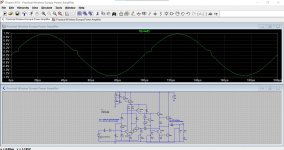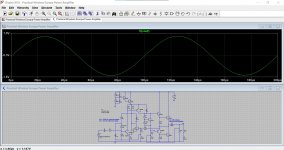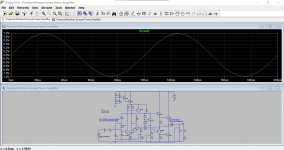A big problem with theoretical correct bias and the manufacturers recommended bias is that the amplifier may not have sufficient heat sink capacity to allow the former.
On my own design amps I apply a small sine wave and monitor output.
I start off with zero bias and turn it up until cross over distortion goes.
The result is usually remarkably low bias current. I have seen it as low as 10mA. It sounds fine so why waste extra power in the heat sink ?
Good point Nigel.
Thanks everyone, and thank you Profiguy for the fulsome explanation and background.
Amp very stable at 7.5mV, will test with cover on top prior to reassembling, but all looking good.
Thank you again.
Thanks everyone, and thank you Profiguy for the fulsome explanation and background.
Amp very stable at 7.5mV, will test with cover on top prior to reassembling, but all looking good.
Thank you again.
On my own design amps I apply a small sine wave and monitor output.
I start off with zero bias and turn it up until cross over distortion goes.
The result is usually remarkably low bias current. I have seen it as low as 10mA. It sounds fine so why waste extra power in the heat sink ?
I used to find when I was playing around with this that anything over a milliamp or so rendered the distortion inaudible. Obviously that is not optimum but it is enough to remove it from audibility.
Here is a sim of a Quasi amp, first with zero bias, then 1 milliamp, then 4 milliamps. Recommended bias was around 25ma (or was it 100) from memory. This is at 10kHz.
Attachments
On my own design amps I apply a small sine wave and monitor output.
I start off with zero bias and turn it up until cross over distortion goes.
The result is usually remarkably low bias current. I have seen it as low as 10mA. It sounds fine so why waste extra power in the heat sink ?
I run all my big PA amps, even the ones I use for home stereo, at 3 mA per output transistor. This works fine with parallel EF3 with 60 to 100 mA in the *driver*. That would normally be considered sacrilege, but it gets the distortion low enough for *me* although far from “optimum”.
I started to measure THD of my 2 DIY power amplifiers ( clones of commercial amplifiers) and 2nd harmonic was decreasing linear during increasing bias, I finished at about 25mv0,22R. As regards 3rd harmonic, it was decreasing up to around optimum recomended bias- 10mv (0,22R) and after it was increasing. Measured at 1W, a will see what happens at higher power.
2nd harmonic is probably more desirable than 3rd, but crossover distortion will be most prominent at powers well below 1 watt. Try 1/2 or even 1/10 watt, it will be easier to see the effect of crossover distortion.
Thanks. I haven't tried lower power for all frequencies yet. I'm using Arta steps and can see what happens from 5Hz to 20kHz. I know that at low power there are some piks at lower frequencies, probably coming from AC supply.
Will try to compare the results.
Will try to compare the results.
If the peaks are at multiples of the AC frequency (60Hz or 50Hz depending where you are located) then likely they are
Hello
I have an Omnitronic P-1000 amplifier that I changed the final transistors on and I want to ask you how is the correct way to adjust the bias.
After half an hour without load, with the volumes at minimum and with the fans connected or disconnected. Why do I ask, because when the fans are off the bias decreases. When the fans are on, the radiator cools down and the bias increases. So please tell me how is it correct. Thank you!
I have an Omnitronic P-1000 amplifier that I changed the final transistors on and I want to ask you how is the correct way to adjust the bias.
After half an hour without load, with the volumes at minimum and with the fans connected or disconnected. Why do I ask, because when the fans are off the bias decreases. When the fans are on, the radiator cools down and the bias increases. So please tell me how is it correct. Thank you!
Depends whether the fans cool the output devices more than the thermal feedback devices or v. versa - for them to have no effect they would have to have equal effect on both so the thermal changes cancel.
For most amps you set the bias on power-up to close to nominal, then let the amp reach thermal equilibrium and check the bias regularly till its stable - then trim to the nominal value. I presume this should not be enough to trigger the fan to come on as there is no signal. Note that I could only find a schematic in the "service document", no instructions.
For most amps you set the bias on power-up to close to nominal, then let the amp reach thermal equilibrium and check the bias regularly till its stable - then trim to the nominal value. I presume this should not be enough to trigger the fan to come on as there is no signal. Note that I could only find a schematic in the "service document", no instructions.
Thank you very much for your help!
I disconnected the fans so I could adjust it better. So, do I leave the amplifier on until it reaches a stable temperature and until the current stabilizes? I noticed that even after half an hour after I leave it on, the current is still decreasing but obviously more slowly.
I disconnected the fans so I could adjust it better. So, do I leave the amplifier on until it reaches a stable temperature and until the current stabilizes? I noticed that even after half an hour after I leave it on, the current is still decreasing but obviously more slowly.
- Home
- Amplifiers
- Solid State
- Bias adjustment


